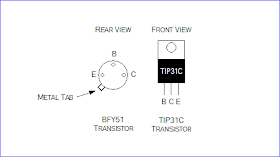This circuit, connected to 32 Ohm impedance mini-earphones, can detect very remote sounds. Useful for theatre, cinema and lecture goers: every word will be clearly heard. You can also listen to your television set at a very low volume, avoiding to bother relatives and neighbors. Even if you have a faultless hearing, you may discover unexpected sounds using this device: a remote bird twittering will seem very close to you.
The heart of the circuit is a constant-volume control amplifier. All the signals picked-up by the microphone are amplified at a constant level of about 1 Volt peak to peak. In this manner very low amplitude audio signals are highly amplified and high amplitude ones are limited. This operation is accomplished by Q3, modifying the bias of Q1 (hence its AC gain) by means of R2.
A noteworthy feature of this circuit is 1.5V battery operation.
List Component
P1 : 22K Log. PotentiometerCircuit from: www.sound.westhost.com
R1,R9 : 10K
R2 : 1M
R3 : 4K7
R4,R7 : 100K
R5 : 3K9
R6 : 1K5
R8 : 100R
C1,C2 : 100nF
C3,C6 : 1µF/63V
C4 : 10µF/25V
C5 : 470µF/25V
D1 : 1N4148
Q1,Q2,Q3 : BC547
Q4 : BC337
MIC1 : electret microphone
SW1 : SPST Switch
J1 : Stereo 3mm. Jack socket
B1 : 1.5V Battery (AA or AAA cell etc.)










